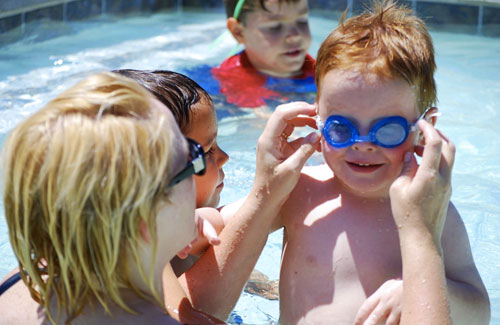Dad keeps Pledge: Girl Walks
Reprinted with permission from the St. Louis Post Dispatch
Last winter, little Stephanie Bridgeman stood helplessly by as her father built a snowman for her.
But Clyde Bridgeman turned to his crippled daughter and said “I promise that I’m going to help you B and next year, you will build a snowman.”
He then guided Stephanie, now 5 years old, through a year of grueling daily exercises. One year later, on Feb. 8, Bridgeman saw his pledge come true when Stephanie built that long-dreamed-of snowman in the back yard of their home in Peoria, Ill.
Stephanie has done much more than snow-sculpting in one year’s time. This spunky cerebral palsy victim has shed both her leg-braces and her walker.
“I can walk a quarter of a mile outside,” Stephanie said proudly in a telephone interview Friday.
That’s quite a feat for a child who less than two years ago could take only three steps with her braces before falling down.
On the day she built her snowman, Bridgeman said, he and his wife, Sharon, were moved to tears when Stephanie told them: “Thanks for keeping your promise.”
Although the Bridgeman’s have given up much of their social life to help Stephanie, they credit a St. Louis group for designing their self-help program and for guiding them through it.
This organization is called The NACD Foundation, with headquarters in Redlands, California. It has regional offices in Dellwood in north St. Louis County and in several other states.
Since 1982, the Bridgemans have made six visits to Dellwood for evaluation and updating of Stephanie’s home exercise program.
The Foundation’s philosophy is that parents can play a vital role in helping children overcome handicaps, says its director, Robert J. Doman, Jr.
But child-rehabilitation experts say there are many kinds of neurological disorders, some of which would not respond to any self-help program. The Bridgeman success story could be a rare event, they caution.
Doman admitted in an interview, “The Bridgeman’s are exceptional B their goals for Stephanie are very high.” But he said they succeeded because they were willing to sacrifice great amounts of time for their daughter.
When she was 9 months old, a neurologist found that Stephanie had paralysis that was caused by an accumulation of fluid in her brain.
Stephanie had three years of standard physical therapy, amounting to three, one-hour sessions a week in a rehabilitation clinic, Bridgeman said.
In fact, Stephanie’s pluck and charm led to her selection as Peoria’s Easter Seal poster child in 1982. Thousands of Illinois residents have seen her on TV.
But despite Stephanie’s celebrity status, her parents felt that she wasn’t progressing well enough.
In the fall of 1982, for example, “Stephanie could take only three steps on her own and then she would fall down, even wearing braces” Bridgeman said.
Her lack of progress prompted the Bridgeman’s to seek the help of the Child Development program here.
They’ve paid about $600 in fees to the program. But that investment has prepared them to spend hundreds of hours in training Stephanie B an effort that’s hard to put a price on, Bridgeman said.
“First, we had to teach her to crawl on her belly and to creep,” he said. Her cerebral palsy hadn’t affected her upper extremities or her speech; her brain damage had affected her from her waist down, he said.
After Stephanie had learned to creep and crawl, Bridgeman improvised a home gym for her. For example, Stephanie tries to learn walking with a normal gait as she holds herself up with an overhead ladder, he said.
The point of this and other physical activity is to stimulate healthy parts of the brain to take over the work of damaged brain tissue, Doman said.
Mrs. Bridgeman added: “Before we started the program, I had to pull her in a cart when I took her shopping with me. Now, she walks comfortably just by holding my hand.”
Stephanie also attends sessions of a preschool program for normal children.
“She gets along well with the other kids,” Mrs. Bridgeman said. “The only time they help her is when they go out to the playground. Because she walks slowly, they push her in a shopping cart, she said.
A few years ago, doctors were unsure how well Stephanie would progress. One surgeon said Stephanie would not walk unless he performed a major operation on her legs.
Today, the Bridgemans are glad they decided against surgery.
“If we hadn’t gotten involved ourselves, Stephanie would still be sitting in the house instead of walking,” Bridgeman said.
Reprinted from the Journal of The NACD Foundation (formerly The National Academy for Child Development)





